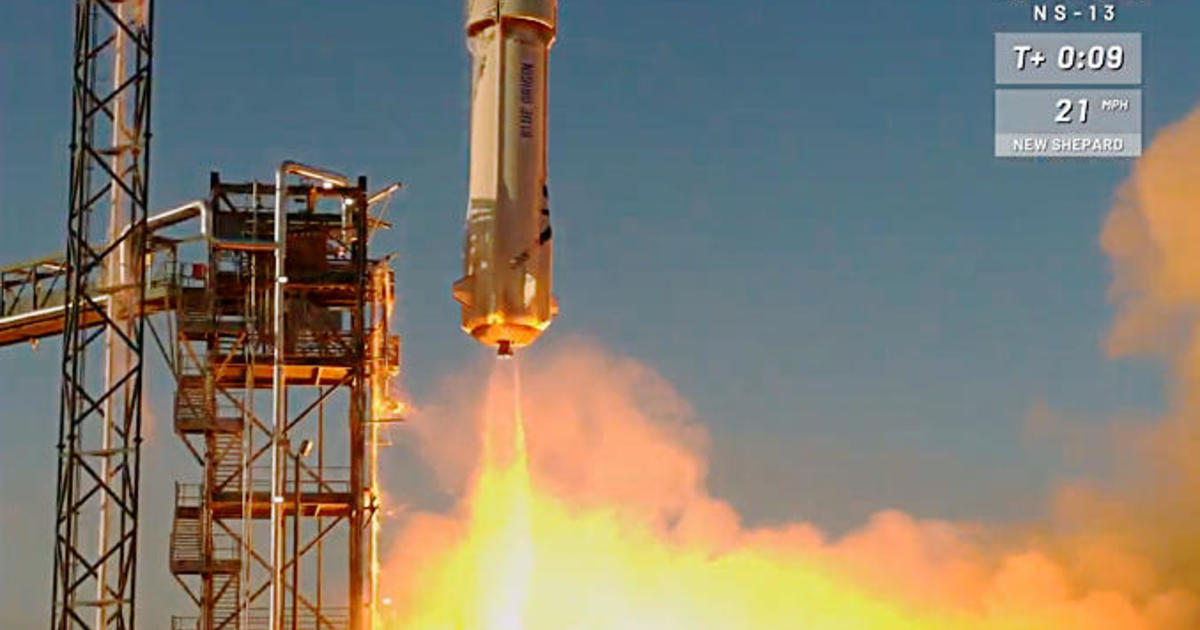A Blue Origin New Shepard rocket boosted an unpiloted crew capsule to the edge of space Tuesday in the company’s 13th sub-orbital test flight, reaching an altitude of 66 miles and giving on-board experiments about five minutes of weightlessness before a picture-perfect parachute descent to Earth.
The capsule’s booster, meanwhile, carried out a rocket-powered landing on a nearby pad while experimental NASA sensors were put through their paces as part of a project to develop safer, more accurate guidance technology for upcoming moon landings in the agency’s Artemis program.
It was the seventh successful flight in a row for the rocket and capsule and the 13th overall for Blue Origin, owned by Amazon founder Jeff Bezos, as the company gears up to begin launching space tourists, researchers and other paying customers on up-and-down sub-orbital spaceflights.
A Blue Origin New Shepard rocket blasts off from West Texas on a sub-orbital test flight, the company’s 13th as it moves closer to begin carrying space tourists and researchers to the edge of space.
Blue Origin webcast
While New Shepard is not capable of orbital flight, passengers will experience a few minutes of weightlessness while taking in the view from altitudes above 62 miles, the internationally recognized “boundary” between the discernible atmosphere and space.
NASA, the Air Force and the Federal Aviation Administration consider 50 miles to be the dividing line while the Fédération Aéronautique Internationale, an international governing body for aviation-related sports and records, puts the threshold at 100 kilometers, or 62 miles.
The New Shepard capsule is designed to exceed both of those standards and the spacecraft did just that Tuesday.
Running nearly three weeks late because of an electrical issue, the booster blasted off at 9:36 a.m. EDT, climbing away atop a brilliant jet of flame. About two minutes and 25 seconds after liftoff, climbing at more than 2,000 mph, the rocket released the New Shepard capsule to soar on its own to an altitude of about 66 miles, or 346,964 feet.
The capsule then began falling back to Earth, deploying three large parachutes before settling to a gentle touchdown 10 minutes and nine seconds after launch. The New Shepard booster, meanwhile, landed under rocket power two-and-a-half minutes earlier.
For Tuesday’s flight, the New Shepard capsule was loaded with 12 commercial payloads, including experiments from NASA, Johns Hopkins Applied Physics Laboratory, the Southwest Research Institute, Space Lab Technologies, the University of Florida and Space Environment Technologies among others.
Also on board: thousands of postcards sent in to Blue Origin’s Club for the Future.
One of the experiments, NASA’s Deorbit, Descent and Landing Sensor Demonstration project, is aimed at developing technology that will allow spacecraft to make precision landings on the moon in an area half the size of a football field. The program is known as SPLICE, a convoluted acronym standing for Safe and Precise Landing – Integrated Capabilities Evolution.
The system uses a specialized computer and three sensors, two of which were mounted on the New Shepard rocket for Tuesday’s flight.
The New Shepard capsule gently lands in a cloud of dust 10 minutes after takeoff, none the worse for its sub-orbital trip to space.
Blue Origin webcast
One sensor mounted near the top of the rocket was devoted to terrain relative navigation, utilizing an inertial measurement unit and a camera to determine the rocket’s precise location during flight.
The second sensor package was designed to fire laser beams at the surface, timing their reflections to determine the rocket’s velocity and altitude. A third sensor, not flown Tuesday, is intended to identify surface hazards as a spacecraft descends so they can be avoided.
Tuesday’s flight was the first of two booked by NASA to test the guidance technology.
“The sensor data is all processed via the descent and landing computer,” John Carson, NASA’s technical integration manager, said in a statement “Lots of other software runs in the background, integrating the different systems, figuring out what needs to run next, and, for this test, synchronizing timing with the Blue Origin flight computer.
“It’s all crucial so the system can run autonomously and provide us with data that we can analyze post-flight.”
Blue Origin is developing both sub-orbital and larger orbit-class New Glenn rockets that will use a powerful new engine, the BE-4, to help boost satellites into orbit. The engines also will be used by United Launch Alliance’s upcoming Vulcan rocket, intended to replace workhorse Atlas and Delta boosters.
Blue Origin has built a huge rocket factory just outside the Kennedy Space Center in Florida to manufacture New Glenn boosters and is developing a launch pad at the nearby Cape Canaveral Air Force Station.
The company also is leading a team designing a moon lander to carry astronauts to and from the lunar surface in NASA’s Artemis program. SpaceX and Dynetics also are designing competing landers. NASA is expected to select one and possibly two designs next February for long-term development.
